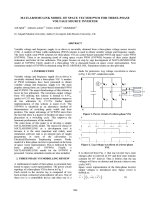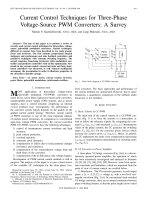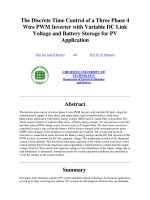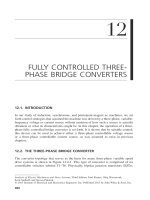Topic 3 three phase motor protection devices
Bạn đang xem bản rút gọn của tài liệu. Xem và tải ngay bản đầy đủ của tài liệu tại đây (1.3 MB, 44 trang )
Topic 3 Three phase motor protection devices
• Motor protection
• Motor protection devices
– star point overloads
• Types of protection devices
– fuses and circuit breakers
– thermal overload
– magnetic overload
– under voltage and overvoltage relays
– electronic motor protection
• Isolation devices
• Timers
• Environmental protection
• Fault finding in three phase motor installations
• Motor circuit faults
Purpose for motor protect
• To protect the motor from Electrical fault:
– Short circuit
– Insulation failure within a winding
• To protect against Mechanical fault:
– Overloading the motor
– Bearing failure
• To protect against environmental conditions
– Humidity
– Ambient temperature
Fuses and Circuit breakers
• Motor fuses and circuit breakers have
special requirements.
• Motor starting current is between 6 – 10
times the normal running current of a
motor.
• A 10A fuse used on a 10A motor would
blow almost instantly with 60A flowing
through it.
HRC Fuses
• These have silica sand to help interrupt
the high fault current on short circuit.
• Silver element with special design to
overcome short term overloads of motor
starting.
• Commonly known as motor start or slow
blow fuses.
Circuit breakers
• Two mechanisms
– Magnetic
– Thermal
• Thermal reacts to overload.
• Magnetic operates very quickly on short
circuit. There are three versions, B, C and
D. The D curve is used for motors.
Circuit breaker tripping curve
Thermal overload
• Has 2 or 3 heating elements connected in
series with the motor.
• These elements are wrapped around a bi
metal strip.
• If the motor draws excess current the bi
metal strip will move, activating a switch.
• The switch will turn off the control circuit.
Bi metal strip
• Two dissimilar metals
that have different
temperature co
efficient of expansion
• When heated, the
strip bends
• Can Protect against:
– Mechanical overload
– Low voltage
– Loss of phase
– Part winding short
Blue button on right is for manual
or auto reset
Single phase motor TOL
• These are a direct acting unit
• They turn off the motor current with their
contacts, rather than the control circuit.
• On Refrigerators, are normally self
resetting.
• Manual reset in most other applications
Star point overloads
• These are placed inside some
hermetic compressors.
• Three direct acting thermal
overloads are connected to the
windings, at the star point, of a
three phase motor.
• They are all linked so as to
ensure all three phases are
turned off.
• Has caused some compressors
to be changed when they only
need wait for O/L to cool down.
Magnetic dashpots
• A large coil
connected in series
with the motor.
• Oil filled cylinder,
with a disc,
connected to a
metal slug.
Operation
• When the motor draws current the coil creates a
magnetic field.
• This is not normally enough to lift the slug
against gravity.
• If excess current is drawn there is enough
magnetic field to lift the slug.
• The oil filled dashpot slows the slug down.
• If the overload lasts long enough it will raise the
slug out of the oil and activate a switch.
• Should always be mounted vertically
• Viscosity and height of oil is critical
• Protects against:
– Mechanical overload
– Low voltage
– Loss of phase
– Part winding short
Phase failure
• Phase failure relays
• As soon as one phase is lost it turns the
motor off.
• Does not wait for TOL to operate.
• Reduces damage to motor.
• Can be used to turn off an entire system in
places where supply is not reliable.
Thermistors
• Small PTC thermistors placed inside the
motor, all connected in series.
• If the motor overheats, the resistance
increases.
• This turns off an external relay.
• The relay then turns off the control circuit.
Motor must be below temperature
for R1 to close
Thermistor terminals
• NEVER
insulation
resistance
test
thermistors
Protection offered
• Thermistors detect the actual temperature
of the motor.
• This is critical in hot environments when
ambient temperature may effect the
efficiency of the cooling system
• In dirty environments when dust and dirt
may clog air vents
Motor protection units
• Modern motor protection units can monitor motor
condition and control the control circuit.
• Current transformers can convey information on
current draw, replacing the TOL
• Phase fail and under voltage can be
incorporated.
• Thermistors can be incorporated.
• Short circuit protection can NOT be offered.
• Many soft starters and VSD units incorporate
these features.
Multiple starting
• When a motor starts the Lock Rotor Amps
can be very high.
• The stress that this can cause to the
insulation, due to heating of the winding,
can be high.
• Manufacturers will normally list a duty of
starting depending on the motor type and
starter fitted
Testing an electric motor
• Windings:
– Windings should be tested for continuity
• Insulation resistance test
– Each winding should be checked to frame at
500V with a reading of not less than 1MΩ
– If windings can be separated the windings
should be tested at 1000V for 3 phase and
500V for single phase









